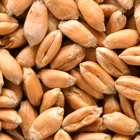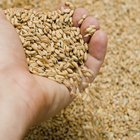
Quasarphoto/iStock/Getty Images
For health-conscious diners, the number and variety of whole grains available presents an embarrassment of riches. Some novel options, such as quinoa, have gained substantial popularity as a healthy alternative to rice and other conventional grains. Kamut, on the other hand, turns up more frequently in baked goods or processed "ancient grains" cereal products. Its large, chewy kernels take longer to cook than quinoa or rice, but it's an intriguing alternative for whole-grain aficionados.
A Quick Introduction
As with durum wheat, its closest relative, Kamut represents a bridge between the most ancient wheat varieties and those of the modern day. Though they share many similarities, including the gluten that gives them bread-making prowess, the older wheat varieties have fewer chromosomes than their modern counterparts. Khorasan wheat -- Kamut is its trademarked name -- was brought to the United States after World War II, and first gained commercial importance in the 1990s. Its golden color and relatively sweet flavor distinguish it from most other types of wheat.
As Whole Kernels
Kamut berries are significantly larger than those of conventional wheat, with a distinctively long and humpbacked shape. The big grains can take over an hour to simmer to tenderness in water or broth. As with black "forbidden" rice, another long-cooking grain, savvy cooks often soak the kernels overnight in cold water. This can shorten the final cooking time by as much as 15 to 20 minutes. Cook it in a saucepan or rice cooker until tender with approximately 3 times its volume of water, and then drain any excess. Let the grain stand for a few minutes to absorb the rest.
Cracked Kamut and Kamut Bulgur
Although Kamut has a fine flavor, some diners find that the sheer size of its kernels makes them wearying to chew. Cracked Kamut addresses this difficulty -- the whole berries are chopped into smaller pieces that cook in roughly two-thirds the time and require much less effort to eat. The cracked grain can be cooked like rice, either simmered in a tightly closed pot or stirred with aromatic vegetables and spices to create a pilaf. Kamut bulgur looks similar, but is a rather different product. The grain is cooked and then dried, producing quick-cooking "groats," before it's cracked. Fine Kamut bulgur can be simmered or simply soaked in hot water for less than 10 minutes, while coarser versions might require up to 20 minutes.
As Hot Cereal
Cracked Kamut or Kamut bulgur are excellent options at the lunch or dinner table, but they can also be prepared as a hot cereal for breakfast. Simply simmer the grains in 3 to 4 times their volume of water, or a mixture of water and milk, until they reach a soft, creamy texture. Some mills produce Kamut specifically for porridge-making, in a finer and quicker-cooking grind. Kamut groats are also available in the form of rolled flakes, similar in appearance to old-fashioned rolled oats. As with oats, Kamut flakes make a hearty hot cereal. Spices and fresh or dried fruit can lend the cereal additional flavors, making it an even better start to your day.
Related Articles

How to Cook Oat Groats in a Crock Pot
Can You Eat Bulgur Like Oatmeal?
Cooking Instructions for Cracked Wheat

How to Cook Bulgar Wheat in the ...

Can You Mix Quinoa & Brown Rice in a ...

Bulgar Wheat Vs. Couscous

How to Cook Steel Cut Oatmeal With a ...

Barley Nutrition Information

What Are Yellow Grits?
How to Cook Burghal

Alternative Flours to Make Pizza

What Is the Difference Between Rolled ...

How to Cook Quinoa Pasta

How to Cook Soft Wheat Berries

What Is White Oat?

What Additives Are in Flour?

How to Cook Soaked Hulled Barley

Is Teff Flour Gluten-Free?

How to Make Bread Flour

How Long Do I Cook Vermicelli?
References
- Kamut.com: The Wheat -- Origin and Taxonomy
- Kamut.com: The Wheat -- History
- Bob's Red Mill: Basic Cooking Instructions for Organic Kamut Berries
- Sunnyland Mills: #1 Fine Organic Kamut Khorasan Bulgur Wheat
- Sunnyland Mills: #3 Coarse Organic Kamut Khorasan Bulgur Wheat
- Bob's Red Mill: Kamut Cereal Cooking Instructions
Resources
Writer Bio
Fred Decker is a trained chef and prolific freelance writer. In previous careers, he sold insurance and mutual funds, and was a longtime retailer. He was educated at Memorial University of Newfoundland and the Northern Alberta Institute of Technology. His articles have appeared on numerous home and garden sites including GoneOutdoors, TheNest and eHow.
Photo Credits
Quasarphoto/iStock/Getty Images